The Samsung 970 EVO Plus (250GB, 1TB) NVMe SSD Review: 92-Layer 3D NAND
by Billy Tallis on January 22, 2019 10:00 AM ESTAnandTech Storage Bench - Heavy
Our Heavy storage benchmark is proportionally more write-heavy than The Destroyer, but much shorter overall. The total writes in the Heavy test aren't enough to fill the drive, so performance never drops down to steady state. This test is far more representative of a power user's day to day usage, and is heavily influenced by the drive's peak performance. The Heavy workload test details can be found here. This test is run twice, once on a freshly erased drive and once after filling the drive with sequential writes.
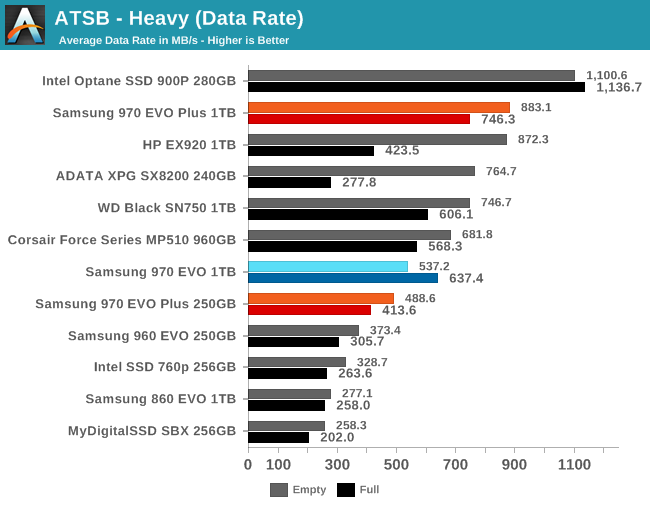
The Samsung 970 EVO Plus does not significantly improve on the best data rates we've seen from TLC SSDs on the Heavy test, and the 250GB model in particular is way behind the 240GB ADATA SX8200. However, the 970 EVO Plus does deliver class-leading full drive performance.
(Our 1TB 970 EVO persistently underperforms expectations when the Heavy test is run on an empty drive, with unusually high read latencies. The drive does not report any media or data integrity errors, and the other 970 EVO and 970 EVO Plus drives do not exhibit this behavior.)
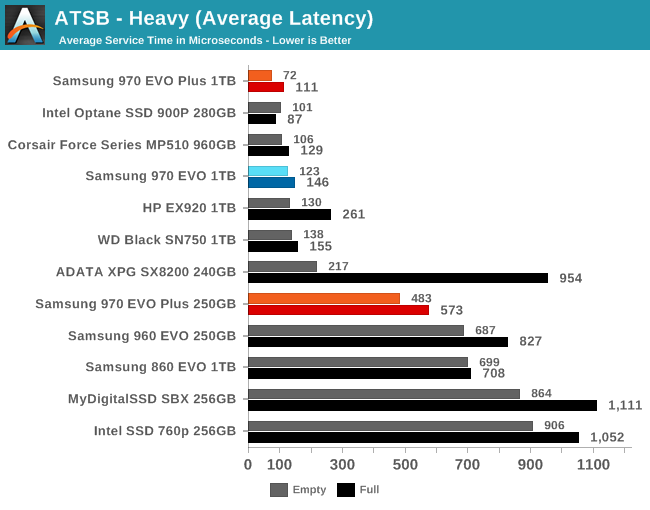
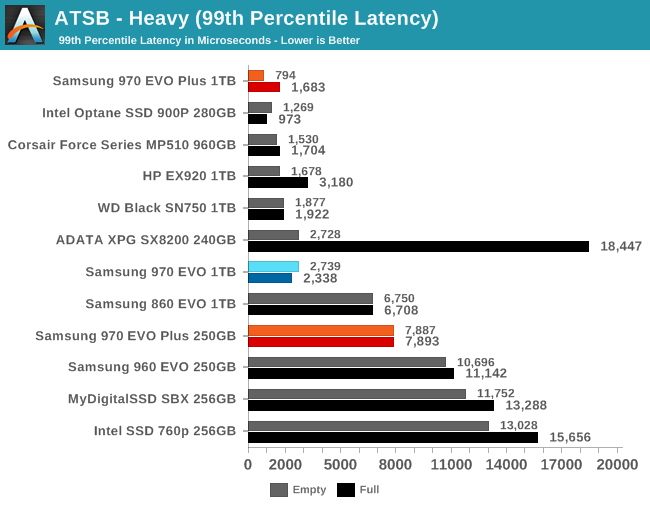
The 1TB 970 EVO Plus turns in great average and 99th percentile latency scores, with the averages on par with the Intel Optane 900P and 99th percentile latency that clearly beats the Optane SSD when the test is run on an empty drive. The 250GB 970 EVO Plus compares favorably with most of the other drives in its capacity class, but the ADATA SX8200 comes out well ahead when the test is run on an empty drive, at the cost of much worse full-drive performance.
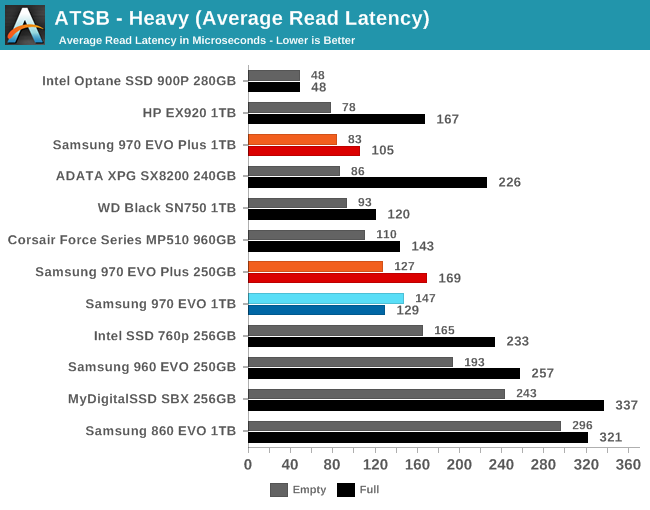
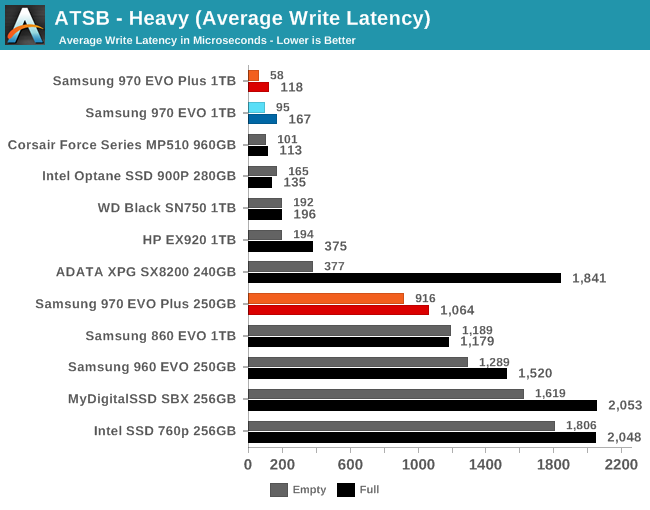
Both capacities of the 970 EVO Plus turn in great average read latency scores, but the average write latencies show a very clear division between the 1TB and 250GB classes. The 1TB 970 EVO Plus leads its class for average write latency while the 250GB model is overshadowed by the empty-drive performance of the ADATA SX8200.
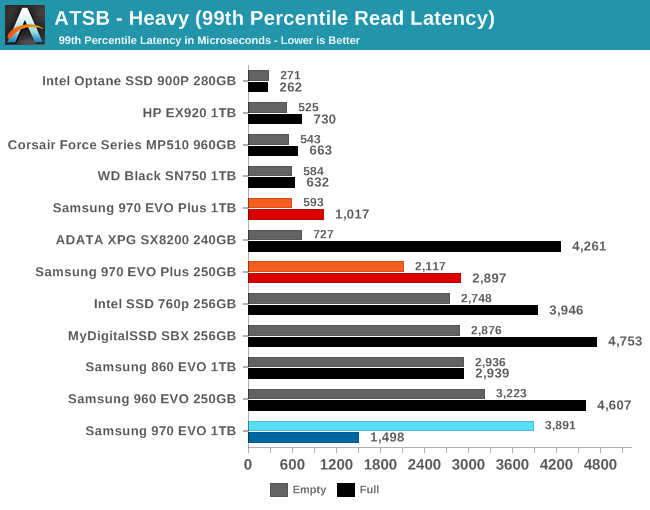
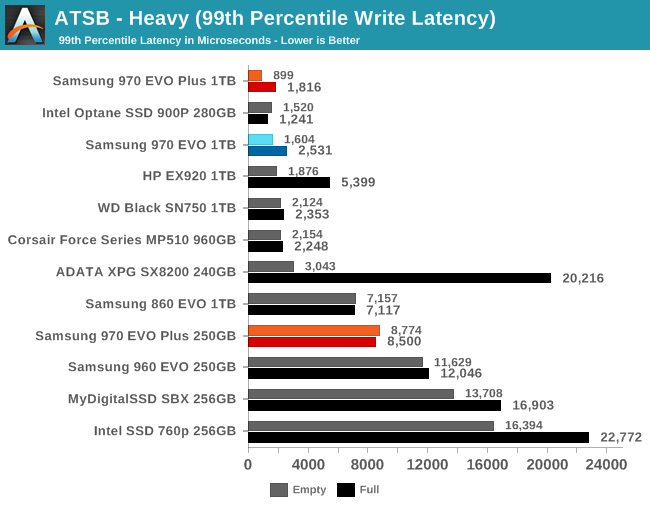
The 99th percentile read and write latency scores both show relatively clear separation between the 1TB and 250GB NVMe drives. The 1TB 970 EVO Plus has excellent 99th percentile write latency but somewhat worse 99th percentile read latency than most of its competition. The 250GB model again looks much better than most of its competition.
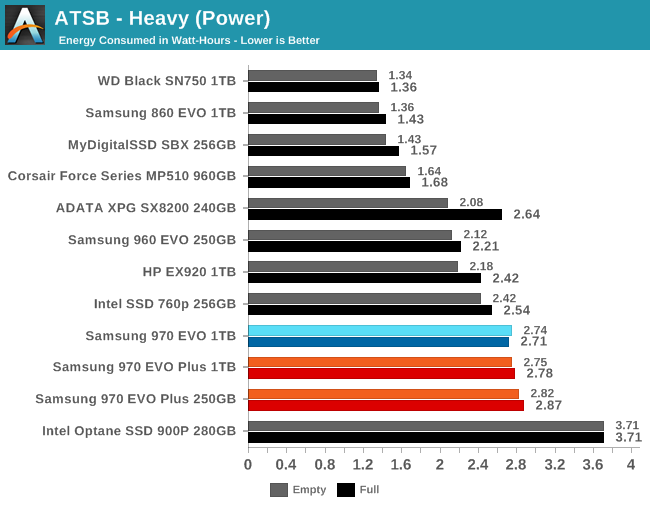
The 970 EVO Plus uses a bit more energy during the Heavy test than its predecessor, keeping it at the bottom of the list while the WD Black SN750 only needs half the energy and several other competitors are well ahead of Samsung.










35 Comments
View All Comments
Chaitanya - Tuesday, January 22, 2019 - link
Quite a minor upgrade over previous drive.jeremyshaw - Tuesday, January 22, 2019 - link
Hence the name.Billy Tallis - Tuesday, January 22, 2019 - link
More substantial than the WD Black SN750.I don't think we'll see any more big jumps until PCIe 4.0 ships. Pretty much everybody has caught up on the NAND side, and most of the controller vendors have had decent NVMe controllers out for a while. There's no low-hanging fruit like there was when companies were still trying to make SM2260 or Phison E7 compete against Samsung with inferior NAND.
DanNeely - Tuesday, January 22, 2019 - link
More to the point it is a consistent incremental improvement. There've been far too many cases over the years when a v.next drive was an incremental improvement in manufacturing cost, that regressed in most to all performance numbers.boozed - Tuesday, January 22, 2019 - link
I call those performance improvements significant (just).Flunk - Thursday, January 24, 2019 - link
I don't think it's enough to elevate this drive over the high-end Silicon Motion drives in real-world uses. Not for consumers at least.nectrone - Thursday, January 24, 2019 - link
96-layer nand is an improvement on production speed, yields, and manufacturing cost, rather than perf. And tbh, we don't need better perf at all, or maybe a bit in 4k random, because 150MBps is a bit low in 2019. Instead, what we need, is prices to drop, below twice the price of an hdd of the same capacity.In 2018, 1TB tlc nvme 64-layer ssd was 10 times the price of an hdd, now in Jan it's 5 times. Sata 64-layer ssd were 7 times the price of hdd, now it's 3. I'd like TLC nvme to cost twice an hdd, and sata tlc to be the same price as an hdd. With 96-layer, we'll get closer to that.
haukionkannel - Tuesday, January 22, 2019 - link
Pity that the consumer version does not get 4.0 this year... I was hoping to have 4.0 compatible ssd when AMD 570x boards comes out. Well most like with my usage even these Are fast enough and I am not going to be Bottle negged by 3.0.sorten - Wednesday, January 23, 2019 - link
I had the same reaction. I'm running an old gaming PC and I'm ready to switch to AMD with a full set of upgrades at the end of the year and was hoping for PCIE 4.0, but my SSD is so old that I know any drive will be a huge improvement.ikjadoon - Tuesday, January 22, 2019 - link
Meta: has the scrolling video ad been moved to the right? It finally doesn't cover up the article when you scroll. Huge thank you.970 EVO Plus: I'm excited for this to get added to the SSD 2018 Bench. Curious how close it matches the 970 PRO 512GB, now at $170. My almost-full 250GB 960 EVO needs a capacity increase and $40 isn't a big difference for a minimum two-year purchase.